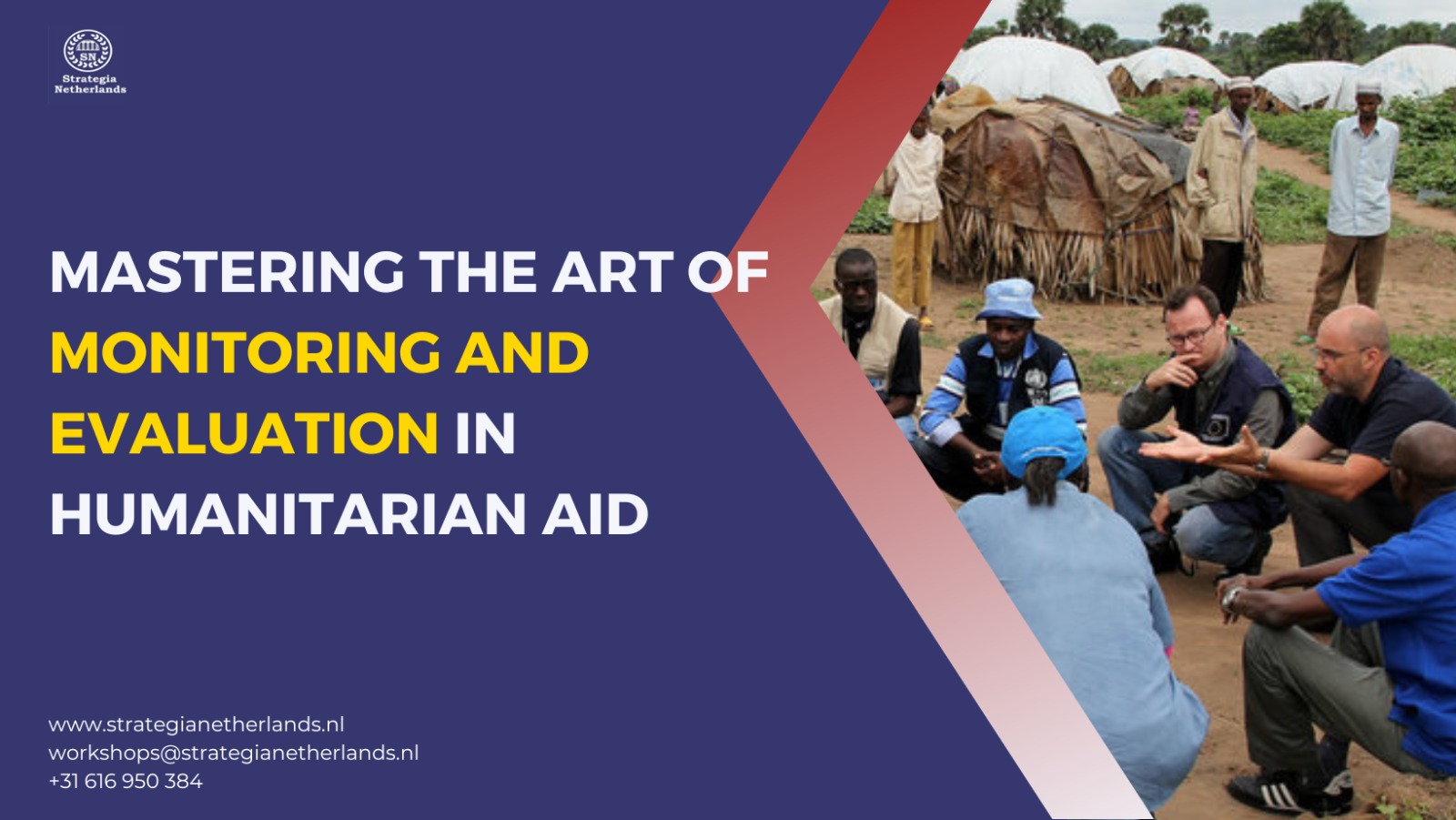- September 26, 2023
- Posted by: strategia
- Categories: blog posts, Uncategorized

In the world of humanitarian aid, where crises unfold swiftly and lives hang in the balance, the ability to master the art of Monitoring and Evaluation (M&E) is nothing short of essential. M&E stands as the guiding beacon for aid organizations, helping them deliver effective, accountable, and high-quality assistance to communities in dire need during crises. In this independent blog post, we’ll explore the art of mastering M&E in humanitarian aid, highlighting its significance, unique challenges, and the pivotal role it plays in ensuring aid reaches those most in need.
The Vital Role of M&E in Humanitarian Aid
When disaster strikes, whether it be a natural catastrophe, a conflict-driven crisis, or a complex humanitarian emergency, aid agencies must respond rapidly and effectively. The lives and well-being of affected populations hinge on the quality and efficiency of the assistance provided. This is where M&E steps into the spotlight.
Monitoring and Evaluation in humanitarian aid is the systematic process of tracking, assessing, and learning from the impact and effectiveness of aid programs. It involves setting clear objectives, defining measurable indicators, collecting data, analyzing results, and using insights to make informed decisions. Here’s why mastering M&E is crucial:
1. Accountability: M&E ensures that aid organizations remain accountable for their actions. It allows them to transparently demonstrate their commitment to alleviating suffering, saving lives, and upholding the dignity of affected communities.
2. Efficiency: By continuously monitoring and evaluating their efforts, humanitarian agencies can identify inefficiencies, streamline operations, and optimize resource allocation. This leads to more effective aid delivery.
3. Adaptability: In rapidly changing crisis scenarios, adaptability is key. M&E provides real-time feedback, enabling aid organizations to adjust their strategies and respond to emerging needs promptly.
4. Learning and Improvement: M&E isn’t just about data collection; it’s about learning from successes and failures. It empowers organizations to evolve, innovate, and fine-tune their approaches for better outcomes.
The Core Humanitarian Standard on Quality and Accountability (CHS)
At the heart of humanitarian M&E lies the Core Humanitarian Standard on Quality and Accountability (CHS). This comprehensive standard sets the stage for principled, accountable, and high-quality humanitarian work. It comprises nine commitments to communities and people affected by crises, each backed by quality criteria, key actions, and organizational responsibilities.
The CHS offers a robust framework for humanitarian organizations to align their practices with the highest standards. Remarkably, approximately one-third of the key actions and organizational responsibilities within CHS explicitly involve or rely on M&E processes. This underscores the pivotal role of M&E in humanitarian programming.
Unique Challenges in Humanitarian M&E
M&E in humanitarian settings presents distinctive challenges due to the urgency of crises and the complexity of delivering aid effectively.
These challenges include:
1. The ‘Good Enough’ Approach: Recognizing that simplicity and efficiency are paramount during the initial stages of a crisis, M&E may begin as a streamlined, practical process that provides timely information for decision-making.
2. Phased M&E: Adaptation is key in humanitarian contexts. Initiating with a lighter-touch approach during emergency response and gradually introducing more comprehensive M&E
elements as conditions stabilize is often the most pragmatic strategy.
3. Adapting to Context: Customizing M&E methodologies to address challenges unique to humanitarian settings, such as assessing risks, ensuring safety, and engaging with affected communities.
4. Ethical Considerations: Addressing ethical issues, including safeguarding data, respecting confidentiality, obtaining informed consent, and upholding the dignity and rights of affected populations.
Mastering the Art of Humanitarian M&E
Mastering the art of M&E in humanitarian aid requires a deep understanding of the CHS, other relevant standards, and the unique challenges faced in crisis situations. Aid organizations must embrace the ‘good enough’ approach when necessary and prioritize adaptability and ethics in their M&E efforts.
Effective integration of M&E into humanitarian programs ensures that aid reaches those who need it most, prevents unintended negative consequences, engages affected communities, and drives continuous improvement through learning and innovation.
Conclusion
Monitoring and Evaluation are not just processes; they are the moral compass guiding humanitarian aid. The Core Humanitarian Standard on Quality and Accountability (CHS) and resources like the Sphere Handbook provide invaluable guidance and support in this journey. In the dynamic realm of humanitarian action, mastering the art of M&E isn’t just a skill; it’s a responsibility. It ensures that when crises strike, aid organizations deliver with precision, saving lives, alleviating suffering, and upholding the dignity of those in need.
To embark on your journey of mastering M&E in humanitarian aid, explore comprehensive courses like those offered by Strategia Netherlands. Equip yourself with the tools and knowledge to make a positive impact in humanitarian crises, one effective monitoring and evaluation .
